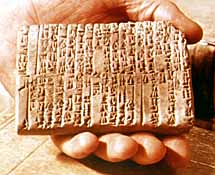|
does archaeology verify the Bible?
Over the years there have been many criticisms leveled against the Bible concerning its historical reliability. These criticisms are usually based on a lack of evidence from outside sources to confirm the Biblical record. Since the Bible is a religious book, many scholars take the position that it is biased and cannot be trusted unless we have corroborating evidence from extra-Biblical sources. In other words, the Bible is guilty until proven innocent, and a lack of outside evidence places the Biblical account in doubt.
This standard is far different from that applied to other ancient documents, even though many, if not most, have a religious element. They are considered to be accurate, unless there is evidence to show that they are not. Although it is not possible to verify every incident in the Bible, the discoveries of archaeology since the mid 1800s have demonstrated the reliability and plausibility of the Bible narrative. Here are some examples.
The discovery of the Ebla archive in northern Syria in the 1970s has shown the Biblical writings concerning the Patriarchs to be viable. Documents written on clay tablets from around 2300 B.C. demonstrate that personal and place names in the Patriarchal accounts are genuine. The name "Canaan" was in use in Ebla, a name critics once said was not used at that time and was used incorrectly in the early chapters of the Bible. The word "tehom" ("the deep") in Genesis 1:2 was said to be a late word demonstrating the late writing of the creation story. "Tehom" was part of the vocabulary at Ebla, in use some 800 years before Moses. Ancient customs reflected in the stories of the Patriarchs have also been found in clay tablets from Nuzi and Mari.
The Hittites were once thought to be a Biblical legend, until their capital and records were discovered at Bogazkoy, Turkey. Many thought the Biblical references to Solomon's wealth were greatly exaggerated. Recovered records from the past show that wealth in antiquity was concentrated with the king and Solomon's prosperity was entirely feasible. It was once claimed there was no Assyrian king named Sargon as recorded in Isaiah 20:1, because this name was not known in any other record. Then, Sargon's palace was discovered in Khorsabad, Iraq. The very event mentioned in Isaiah 20, his capture of Ashdod, was recorded on the palace walls. What is more, fragments of a stela memorializing the victory were found at Ashdod itself.
Another king who was in doubt was Belshazzar, king of Babylon, named in Daniel 5. The last king of Babylon was Nabonidus according to recorded history. Tablets were found showing that Belshazzar was Nabonidus' son who served as coregent in Babylon. Thus, Belshazzar could offer to make Daniel "third highest ruler in the kingdom" (Dan. 5:16) for reading the handwriting on the wall, the highest available position. Here we see the "eye-witness" nature of the Biblical record, as is so often brought out by the discoveries of archaeology.

Source: http://www.christiananswers.net/
hmm, i found this interesting. i like reading these kinds of articles to see how Christianity fits in with the rest of the world, even though i think true believers wouldn't need this kind of evidence to verify their faith. i think there was a thread a while back about whether the Bible was true or not, so maybe these kinds of articles can answer questions.
|










